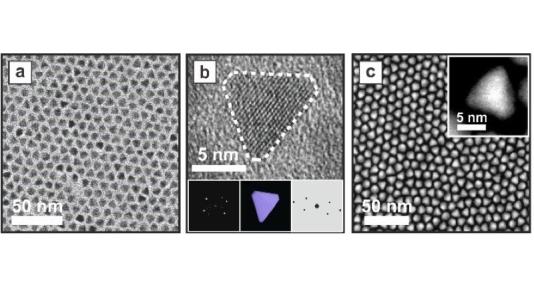
Scientific Achievement
Using self-assembly methods we produced and, for the first time, observed single-component tetrahedral building blocks in three distinct complex superstructures, including a one-dimensional chiral tetrahelix.
Scientific Achievement
Using self-assembly methods we produced and, for the first time, observed single-component tetrahedral building blocks in three distinct complex superstructures, including a one-dimensional chiral tetrahelix.
Significance and Impact
The observations expand the collection of super-structures that can use tetrahedral building blocks; the findings bring the spontaneous formation of nanocrystal assemblies to a higher level of complexity, including chirality in some cases.
Research Details
- Truncated tetrahedral quantum dots in solution self-assembled into one, two, and three dimensions with one common structural feature: preferred facet-to-facet alignment.
- Scanning TEM (STEM) and STEM-energy dispersive X-ray spectroscopy (EDS) mapping were performed at the Center for Nanoscale Materials.
DOI: doi.org/10.1038/s41586-018-0512-5
This work was performed in part at the Center for Nanoscale Materials.
About Argonne’s Center for Nanoscale Materials
The Center for Nanoscale Materials is one of the five DOE Nanoscale Science Research Centers, premier national user facilities for interdisciplinary research at the nanoscale supported by the DOE Office of Science. Together the NSRCs comprise a suite of complementary facilities that provide researchers with state-of-the-art capabilities to fabricate, process, characterize and model nanoscale materials, and constitute the largest infrastructure investment of the National Nanotechnology Initiative. The NSRCs are located at DOE’s Argonne, Brookhaven, Lawrence Berkeley, Oak Ridge, Sandia and Los Alamos National Laboratories. For more information about the DOE NSRCs, please visit https://science.osti.gov/User-Facilities/User-Facilities-at-a-Glance.
Argonne National Laboratory seeks solutions to pressing national problems in science and technology. The nation’s first national laboratory, Argonne conducts leading-edge basic and applied scientific research in virtually every scientific discipline. Argonne researchers work closely with researchers from hundreds of companies, universities, and federal, state and municipal agencies to help them solve their specific problems, advance America’s scientific leadership and prepare the nation for a better future. With employees from more than 60 nations, Argonne is managed by UChicago Argonne, LLC for the U.S. Department of Energy’s Office of Science.
The U.S. Department of Energy’s Office of Science is the single largest supporter of basic research in the physical sciences in the United States and is working to address some of the most pressing challenges of our time. For more information, visit https://energy.gov/science.